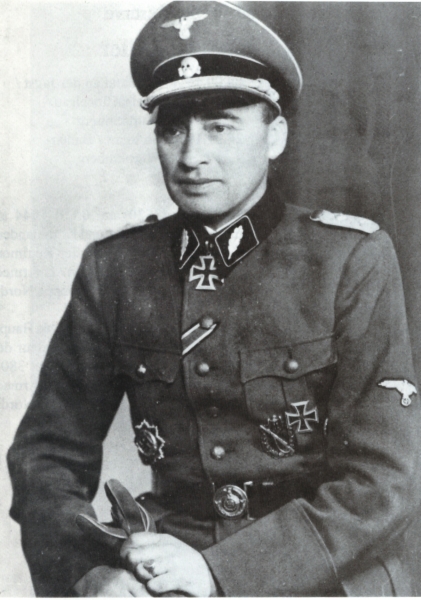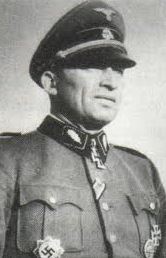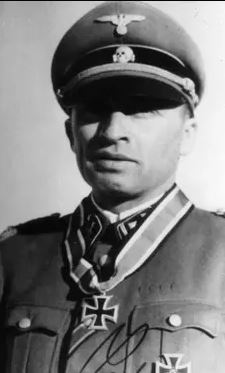Zehender, August Friedrich (Waffen SS)
- Date of birth:
- April 28th, 1903 (Aalen/Württemberg, Germany)
- Date of death:
- February 11th, 1945 (near Budapest, Hungary)
- Buried on:
- German-Hungarian War Cemetery Budaörs
Plot: 1. Grave: UNK. - Service number:
- SS-Nr.: 224.219 // NSDAP-Nr.: 4.263.133
- Nationality:
- German
Biography
Promotions:
00.10.1931: Feldwebel
00.00.1933: SA-Mann
00.00.1933: SA-Untersturmführer
09.11.1935: SS-Obersturmführer
20.04.1937: SS-Hauptsturmführer
13.12.1940: SS-Sturmbannführer
09.11.1942: SS-Obersturmbannführer
20.04.1943: SS-Standartenführer
16.10.1944: SS-Oberführer
15.01.1945: SS-Brigadeführer und General-Major der Waffen-SS
Career:
00.00.1918: Unteroffiziersschule in Ellwangen
00.00.1920: entered the Reichswehr and posted to the 25. Schützen-Regiment at Schwäbisch Gmünd
00.00.1932: retired as Feldwebel
00.00.1933: joined the SA, Sportabteilung, Ausbildungswesen der SA
00.00.1934: SA-Ustuf, Leiter, SA-Sportschule Schloss Kapfenburg, Aalen
00.11.1933-01.09.1936: SA-Ustuf, 12. Sturm, III. Sturmbann, SS-Standarte 'Deutschland'
09.11.1935: joined the SS
00.00.1935-00.05.1938: SS-Ostuf, Zugführer - 12. MG-Kompanie, III. Bataillon, SS-Standarte „Germania" - Ellwangen
01.09.1936-01.05.1938: SS-Ostuf, Chef, 12. Sturm, SS-Standarte "Deutschland", SS-VT
01.05.1937: joined the NSDAP
01.05.1938-00.06.1939: SS-Hstuf, Chef, 8. Sturm, SS-Standarte "Deutschland", SS-VT
00.06.1939-20.12.1940: SS-Hstuf, Chef, 4. Sturm, SS-Standarte "Deutschland", SS-VT - campaign in Poland and France
20.12.1940-00.02.1941: SS-Stubaf, Kdr., I. Bataillon - SS-Regiment 11
00.02.1941-29.06.1941: SS-Stubaf, Kdr, Kradschützen-Bataillon 2 - SS-Division „Das Reich" : campaign in the Balkans then in Russia
25.06.1941: SS-Stubaf, severely WIA at Losza, Eastern Front and evacuated to a Lazarett in Germany
00.10.1941: SS-Stubaf, SS-Kavallerie-Brigade
00.03.1942-00.03.1943: SS-Stubaf, Kdr., SS-Kavallerie-Regiment 2, SS-Kavallerie-Division
18.03.1942-15.04.1942: SS-Stubaf, Kdr., Kampfgruppe 'Zehender', SS-Kavallerie-Division
15.04.1942-15.02.1943: SS-Stubaf, Kdr., SS-Kavallerie-Regiment 2, SS-Kavallerie-Division
00.07.1942: Truppenübungsplatz Heidelager, Debica
00.08.1942: SS-Stubaf, Führer, SS-Kampfgruppe 'Zehender', SS-Reiter-Regiment 2 + 2. Schwadron, SS-Radfahr-Aufklärungs-Abteilung + SS-Artillerie-Regiment
00.01.1943: took control of the village Cholomedina
15.02.1943-30.03.1943: SS-Ostubaf, Kdr., Kampfgruppe 'Z' or 'Zehender', SS-Reiter-Regiment 2, XXXXVII. Panzer-Korps - Dmitrovsk,Orel,
15.03.1943: severe fightings near Komaritschi,South of Dmitrovsk,Orel
00.04.1943: Lapitschi
30.03.1943: SS-Ostubaf, Kdr., SS-Kavallerie-Regiment 3, SS-Kavallerie-Division
17.10.1943-20.02.1944: SS-Staf, Kdr, SS-Kavallerie-Regiment 17, 8. SS-Kavallerie-Division "Florian Geyer" after renaming
00.10.1943: SS-Staf, WIA and evacuated to a Lazarett
00.12.1943: SS-Staf, Kdr, SS-Kavallerie-Regiment 17, 8. SS-Kavallerie-Division "Florian Geyer"
01.02.1944: SS-Staf, WIA and evacuated to a Lazarett
21.04.1944: SS-Staf, creation and training of the future 22. SS-Freiwilligen-Kavallerie-Division "Maria Theresia", Hungary
01.05.1944-11.02.1945: SS-Staf, Kdr., 22. SS-Freiwilligen-Kavallerie-Division "Maria Theresia"
00.10.1944: SS-Ofu, Kdr., 22. SS-Freiwilligen-Kavallerie-Division "Maria Theresia" - Operation Panzerfaust, Hungary then Battle of Budapest
11.02.1945: SS-Brif, Kdr., 22. SS-Freiwilligen-Kavallerie-Division "Maria Theresia" encircled in Budapest, KIA when trying ot break out of Budapest
Do you have more information about this person? Inform us!
- Period:
- Second World War (1939-1945)
- Rank:
- SS-Hauptsturmführer (Captain)
- Unit:
- Chef, 4. Kompanie, SS-Standarte "Deutschland", SS-VT
- Awarded on:
- September 14th, 1939
- Period:
- Second World War (1939-1945)
- Rank:
- SS-Hauptsturmführer (Captain)
- Unit:
- Chef, 4. Kompanie, SS-Standarte "Deutschland", SS-VT
- Awarded on:
- June 18th, 1940
- Period:
- Second World War (1939-1945)
- Rank:
- SS-Hauptsturmführer (Captain)
- Unit:
- Chef, 4. Kompanie, SS-Standarte "Deutschland", SS-VT
- Awarded on:
- 1940
- Period:
- Second World War (1939-1945)
- Awarded on:
- June 1941
- Period:
- Second World War (1939-1945)
- Rank:
- SS-Sturmbannführer (Major)
- Unit:
- Kommandeur, SS-Kavallerie-Regiment 2, SS-Kavallerie-Division
- Awarded on:
- October 16th, 1942
Award 211/30.
- Period:
- Second World War (1939-1945)
- Rank:
- SS-Obersturmbannführer (Lieutenant-colonel)
- Unit:
- Kommandeur, SS-Kavallerie-Regiment 2, SS-Kavallerie-Division, 9. Armee, Heeresgruppe Mitte
- Awarded on:
- March 10th, 1943
“On the 26.11.1942 the SS-Kav.Rgt. 2 was dispatched to seal off the breakthrough southwest of Belyi. Upon reaching Baturino after a forced march, it received the mission to standby and await the orders of the Division. Immediately dispatched reconnaissance from here revealed that the enemy was already in Cholomedina with about 25 tanks and 300-400 men, which placed them in the rear of SS-Kav.Rgt. 1 and the deep flank of the Division as a whole. SS-Obersturmbannführer Zehender realized that this force posed a great danger to the Division itself (which was still in the process of marching to the frontline) as well as the execution of its assigned mission to seal off the breakthrough. Thus, going against his existing orders, he attacked after midnight on his own initiative with the support of 1 Batterie of light field guns and 1 Flak gun (8.8 cm). With the help of good moonlight, it was possible for this force to eject the enemy from Cholomedina after a hard fight.
On the following day the enemy launched another attack with larger numbers of forces, with the objective of recapturing Cholomedina and the road that led through the town (which was of great importance as a march and supply road for friendly motorized elements). Although his Regiment sustained heavy losses in the ensuing combat, SS-Obersturmbannführer Zehender managed to hold the attained line with his men during both days of combat. This result, largely borne of the commander’s own personal intervention and inspiring bravery in the frontline, ultimately spelled the end for the enemy’s forward advance and their plans to roll up the friendly frontline (which would thereby expand their penetration in the frontline).
Later on the 02.12.1942, through a combination of friendly reconnaissance and prisoner statements, SS-Obersturmbannführer Zehender was able to determine the existence of an imminent enemy attack from the woods. He thus decided to launch a preemptive strike with his subordinated Schi-Bataillon on his own initiative. In the fighting which followed he bypassed the enemy flank with a Kompanie and struck the hostile supply network. This resulted in the destruction of several field kitchens, supply dumps and vehicles carrying fuel and ammunition.
The Bataillon was encircled for 24 hours, however thanks to the leadership and exemplary conduct of SS-Obersturmbannführer Zehender it managed to break out of the enemy ring.
As a result of this preemptive strike the enemy’s attack was called off. It had been intended that this attack would finally break through the thinly occupied friendly lines (caused by high losses) and reach the important road.
Zehender thus had a significant share in the success of the overall operation due to his Regiment’s capture of Cholomedina and its road as well as the attack launched behind the enemy positions. These actions, conducted on his own initiative, in turn contributed to the encirclement and destruction of those enemy forces that had broken through southwest of Belyi.
SS-Obersturmbannführer Zehender is therefore particularly worthy of being awarded the Knight’s Cross to the Iron Cross. He has particularly distinguished himself through his decisiveness not only here, but also in the campaigns in Poland, France, Serbia, Greece and the Soviet Union in the year 1941. Zehender already is a bearer of the German Cross in Gold, and has been wounded a total of 3 times.”
1586th Award.
- Period:
- Second World War (1939-1945)
- Awarded on:
- October 1943
- Period:
- Second World War (1939-1945)
- Awarded on:
- November 1943
- Period:
- Second World War (1939-1945)
- Awarded on:
- February 1944
- Period:
- Second World War (1939-1945)
- Awarded on:
- 1944
- Period:
- Second World War (1939-1945)
- Awarded on:
- 1944
- Period:
- Second World War (1939-1945)
- Rank:
- SS-Brigadeführer / Generalmajor der Waffen-SS (Brigadier)
- Unit:
- Kommandeur, 22. SS-Freiwilligen-Kavallerie-Division, "Maria Theresia", Festung Budapest
- Awarded on:
- February 1st, 1945
722nd Award.
Sources
- Photo 1: Wilco Vermeer
- Photo 2:
- Photo 3:
- Photo: Wilco Vermeer collection, the Netherlands
- - MOONEY, PETER, Waffen-SS Knights and their Battles, Schiffer Publishing, Ltd, 2010.
- THOMAS, FRANZ & WEGMANN, GüNTER, Die Eichenlaubträger 1940-1945, Biblio-Verlag, 1998.
- zehender august.JPG.
- ZEHENDER august.JPG0.JPG.
- zehender august.JPG3.JPG.
- Die Ordensträger der Deutschen Wehrmacht
- Die Eichenlaubträger 1940-1945, Deutsches Wehrkundearchiv, 2001
- Fellgiebel, Walther-Peer, Elite of the Third Reich - The Recipients of the Knight's Cross of the Iron Cross 1939-45: A Reference, Helion & Company Limited, England, 2003
- Yerger, Mark C., Waffen-SS Commanders – The Army, Corps and Divisional Leaders of a Legend; Krüger to Zimmermann, Schiffer Publishing Ltd., USA, 1999
- Williamson, G., The Waffen-SS (3) – 11. to 23. Divisions, Osprey Publishing Ltd., Great Britain, 2004
- Axis Biographical Research
- Microfilm Publication A3343. US National Archives






















